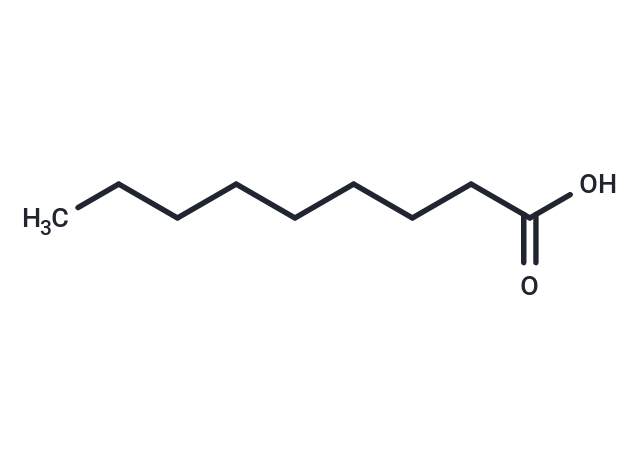Shopping Cart
- Remove All
 Your shopping cart is currently empty
Your shopping cart is currently empty

Nonanoic acid (Nonoic acid) is a fatty acid which occurs naturally as esters are the oil of pelargonium. Synthetic esters, such as methyl nonanoate, are used as flavorings. Pelargonic acid is an organic compound composed of a nine-carbon chain terminating in a carboxylic acid. It is an oily liquid with an unpleasant, rancid odor. It is nearly insoluble in water, but well soluble in chloroform and ether.

| Pack Size | Price | Availability | Quantity |
|---|---|---|---|
| 5 g | $29 | In Stock | |
| 1 mL x 10 mM (in DMSO) | $39 | In Stock |
| Description | Nonanoic acid (Nonoic acid) is a fatty acid which occurs naturally as esters are the oil of pelargonium. Synthetic esters, such as methyl nonanoate, are used as flavorings. Pelargonic acid is an organic compound composed of a nine-carbon chain terminating in a carboxylic acid. It is an oily liquid with an unpleasant, rancid odor. It is nearly insoluble in water, but well soluble in chloroform and ether. |
| Alias | pelargonic acid, Nonoic acid |
| Molecular Weight | 158.24 |
| Formula | C9H18O2 |
| Cas No. | 112-05-0 |
| Smiles | CCCCCCCCC(O)=O |
| Relative Density. | 0.906 g/cm3 at 25℃ (lit.) |
| Storage | Powder: -20°C for 3 years | In solvent: -80°C for 1 year | Shipping with blue ice. | |||||||||||||||||||||||||||||||||||
| Solubility Information | DMSO: 45 mg/mL (284.38 mM), Sonication is recommended. | |||||||||||||||||||||||||||||||||||
Solution Preparation Table | ||||||||||||||||||||||||||||||||||||
DMSO
| ||||||||||||||||||||||||||||||||||||

Copyright © 2015-2025 TargetMol Chemicals Inc. All Rights Reserved.